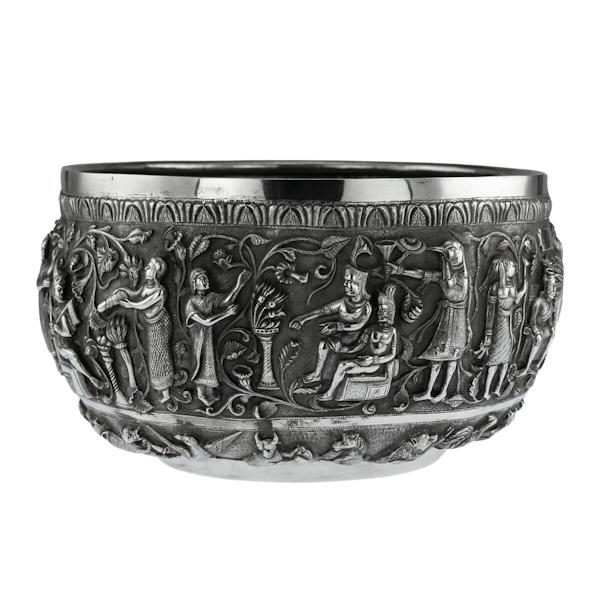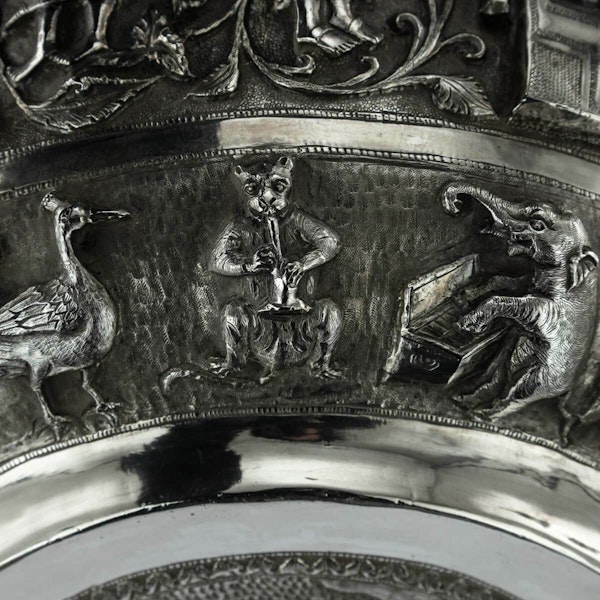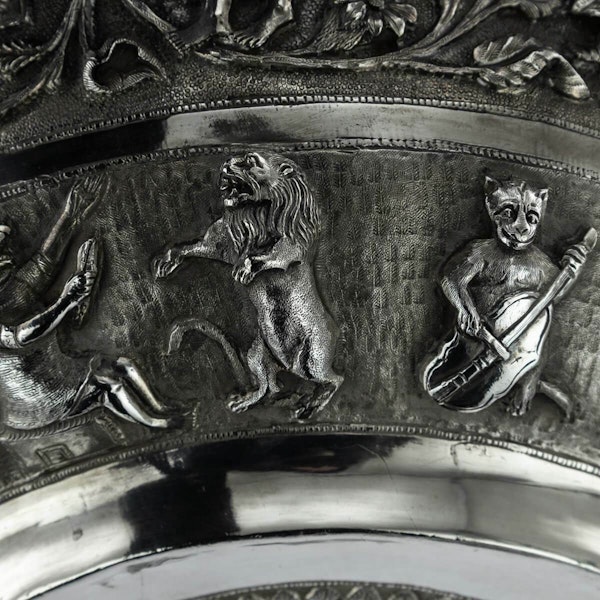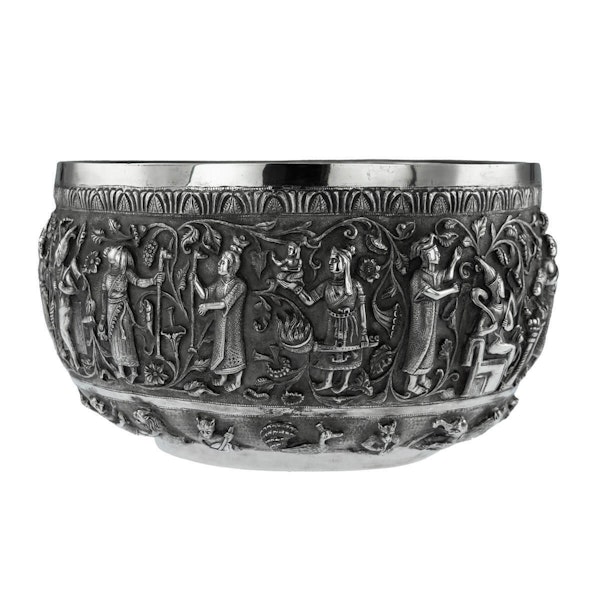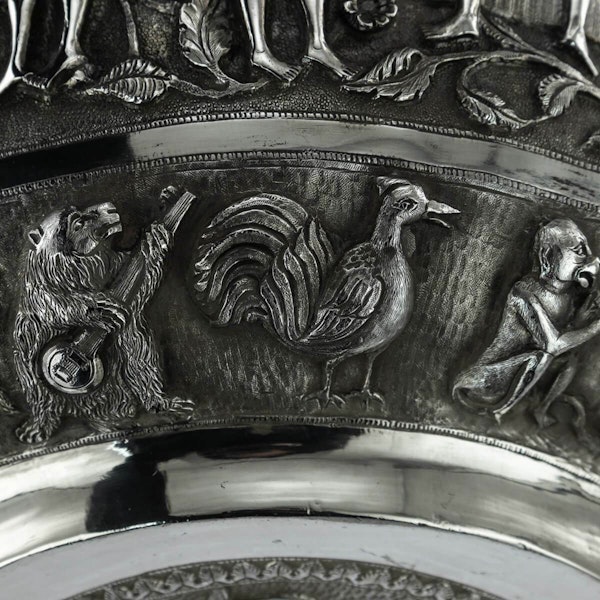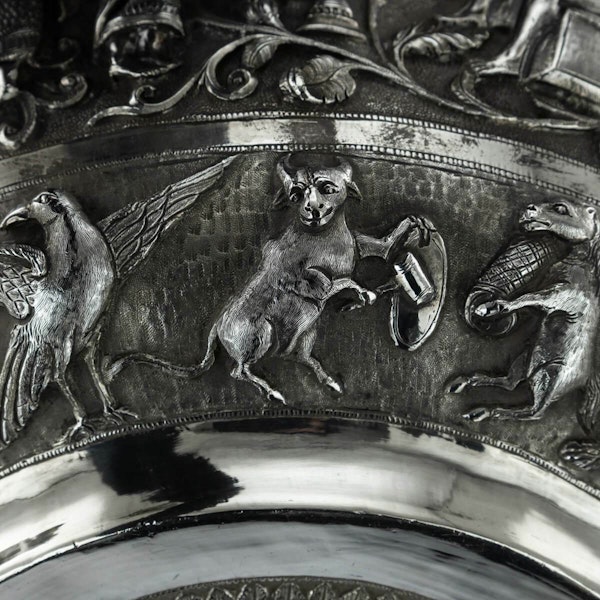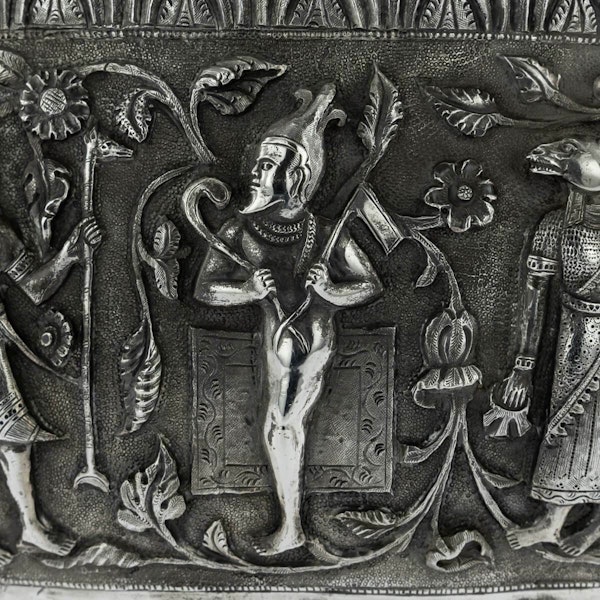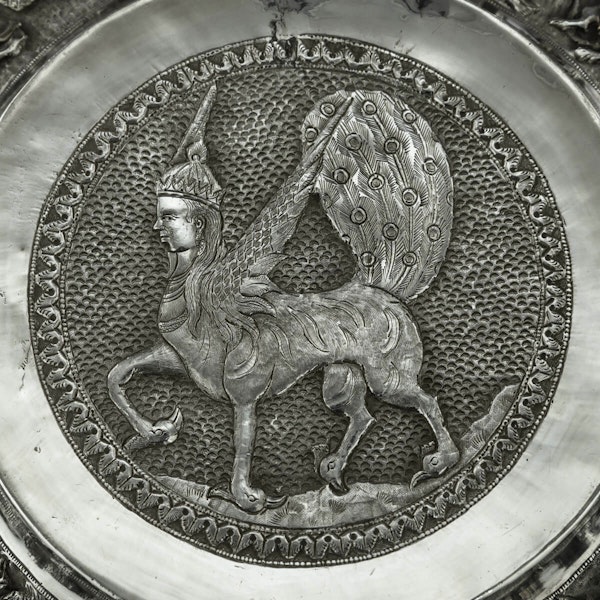Unusual Indian Silver Bowl, Tutankhamun, Large Size, Signed, India – Circa 1925
Unusual Indian Silver Bowl, Tutankhamun, Large Size, Signed, India – Circa 1925
£9,500.00
Description
This extremely unusual antique Indian silver bowl is of large size, boasting a diameter of 34 cms and stands 18.5 cms high from base to rim. It weighs just under two and a half kilograms. The bowl has been ornamented using repousse, chasing and engraving. We believe that the bowl was made in the first quarter of the 20th century, probably shortly after Howard Carter, the British archaeologist and Egyptologist, became world famous after discovering the intact tomb KV62 in the Valley of the Kings, the resting place of the 18th Dynasty Pharaoh, Tutankhamum, commonly referred to as ‘the boy king’ in November 1922.
Pictures of this sensational tomb with its amazing contents featured heavily in newspapers around the world, resulting in a frenzy of interest. The images were heavily copied and inspired many artists to create objects in the Egyptian style which became the latest fashion. There was a surge of interest in the ancient Egyptians, their mythology and the pantheon of Egyptian Gods. There is a vacant cartouche on the side of the bowl which can be found to the top of the principal border.
The pictorial ‘signature’ of the maker has been engraved to the underside of the bowl. This depicts a composite creature with the body of a winged horse with a peacock’s tail and a human face, which is known as a Buraq. By choosing this symbol to mark his work, it also indicates that the silversmith who made the bowl was most probably Moslem, a follower of the Islamic faith.
In Indian and Persian Islamic art, the Buraq is depicted as having a beautiful, usually female, humanoid face with the body of a white horse, colourful wings attached to its shoulders and the tail of a peacock. It is believed that the physical description of the creature might originate from a misinterpretation or mistake when translating the hadith texts of the Koran from Arabic to Persian. The phrase that was used was: “beautiful-faced creature”. This phrase captured the imagination of Indian and Persian artists and examples of 16th century paintings of a human-faced, horse-bodied Buraq are known although in the scripture itself it was never written that the Buraq was winged or that it had a humanoid face.
A short distance under the rim is a repeating vegetal border with beaded borders which lies immediately above the deep Egyptian inspired principal border. Below this, a narrow plain silver ribbon border provides contrast to the rich ornamentation and echoes the band of plain silver under the rim, balancing the design.
The principal border depicts deities from the Egyptian patheon. Often, the gods can be identified as such by their dress and the objects they hold or carry. The animal headed staff or sceptre, called a was, traditionally signified a male deity but here it seems also to have been used to denote a Goddess. The symbol of a staff with triangular appendage to the top, is also the picture representing the word ‘God’ in Egyptian hieroglyphs. Many of the figures also hold an ankh symbol. This represents eternal life and a drawing of an ankh was the hieroglyph used for the word life. Commonly, the looped top of the ankh is held in the hand with the bottom of the cross only visible. Many of the figures depicted on the bowl are holding an ankh.
The scenes on the bowl appear to be a composite of wall paintings and objects which were found in the tomb of Tutankhamun and ancient Egyptian beliefs. Among the objects were the mummified remains of two of Tutankhamun's children, probably stillborn. It seems likely that the bowl was commissioned as a memorial object for the elderly Indian gentleman with the moustache depicted in the principal border. Perhaps he too had lost a baby, which might explain the theme chosen for the lower border.
The first image shows, from left to right, the God Anubis (fully visible), the Goddess Nut and the God Osiris, Osiris is weighing the heart of Tutamkhamun - represented by a miniature version of Tutankhamun - against the feathers in his scales.
In Egyptian belief, the weighing of the heart was a ceremony where the God Anubis/Osiris would judge the dead using a feather which represents the Goddess of truth and justice, Ma'at. Hearts heavier or lighter than the feather were rejected and eaten by Ammit, Devourer of souls.
The next image appears to show (the dead) Tutankhamun kneeling on a chair waiting to hear the judgement from the weighing. Behind him stands the God Horus holding out a torch.
The second photo shows the God Amun, arguably the most important god in the Egyptian pantheon. Amun adopts the traditional pose with his left leg forward. He can be identified by his characteristic flat-topped crown, supporting tall feathers. He has the Gods' braided beard with a curled tip and carries a flail in his left hand with a crook placed across his chest. To his right is the jackal headed God Anubis, who appears again on the left hand side behind Osiris. Anubis and Osiris are both connected with death and the afterlife.
In the fourth image, under the vacant cartouche is an Indian gentleman with a moustache, seated. To his right stands the God Horus. The Indian gentleman appears in the scene again, seated next to Tutankhamun as they both wait to hear what their fate in the afterlife will be.
The last image of the principal scene is believed to show the Goddess Wadjet standing behind the seated God Amun. In front of Amun a man holds out a swaddled baby. This is thought to refer to the stillborn children buried with their father in the tomb. Wadjet has her arms raised to receive the baby.
The silver background has been finely incised to contrast with the raised three-dimensional figures with their elaborate and highly detailed clothing. Large flowering plants, vines and creepers fill the spaces around the figures, adding interest to the scenes. Some of the flowers are in very high relief, stylised but also handled with sensitivity and finely modeled.
The jolly border around the base is of very different style and depicts a frieze of animals with musical instruments. Although the Indian deity Ganesh was often depicted playing musical instruments, such as the tabla drums, we have been unable to identify examples from the Indian artistic tradition where a group of various animals are playing musical instruments. It is therefore likely that the inspiration for this charming border stems from another artistic tradition. We have identified the European and/or Japanese as strong possibilities, albeit with an Indian twist.
This border is a whimsical flight of fantasy which holds universal appeal and has been well executed. It is particularly appealing to children or the ‘child in all of us’ and follows the tradition of anthropomorphising animals, bestowing them with human emotions, drawing them undertaking human tasks or dressing them in human clothes. The popular books written and illustrated by Beatrix Potter would be a good example of this genre. There does not appear to be an obvious connection between the subject matter of the principal border and the lower border save for the animal headed deities of the former and the animal musicians of the latter.
Amongst the animals portrayed in the lower border are four birds, including a peacock and a cock, whose voices or bird calls are their instruments; a bull and a cow playing gongs; a dog playing a tambourine, an elephant a piano; a tiger playing drums; a monkey a horn and a boar a trumpet.
There are three potential sources dating from the 18th and 19th centuries which may, singly or in combination, have inspired this design. First is the story of "The Town Musicians of Bremen" (Die Bremer Stadtmusikanten), a popular fairy tale which was first published by the Brothers Grimm in ‘Grimms’ Fairy Tales’ in 1819. It tells the story of four aging domestic animals, a donkey, a dog, a cat and a rooster, who after a lifetime of hard work and service are no longer wanted by their former masters. Eventually, independently, they all decide to run away from home and meet each other as they journey, deciding to band together and become town musicians in the German city of Bremen. In the 1920s, a charming series of postcards illustrating this story was produced in Stuttgart with illustrations by the German artist, Oskar Herrfurth. The second source is whimsical paintings from the 1880s by the Japanese artist, Kawanabe Kyosai. Two examples are held within the collection of the British Museum, one depicts a group of dancing frogs, some of which are playing musical instruments and another depicts a Shinto band comprising a mixed group of animals playing musical instruments. The third source is porcelain from the Meissen factory. In the mid-18th century, Johann Joachim Kändler (1706-1775) was an artist at the Meissen factory who was responsible for some of Meissen’s most notable designs during its ‘Golden Age’. Kandler’s ‘monkey orchestra’, a large group of individual porcelain figures of monkeys playing musical instruments, became one of Meissen’s most notable and celebrated designs.
| item details | |
|---|---|
| Origin | Asian |
| Period | 20th Century |
| Style | Other |
| Condition | Excellent |
| Dimensions | Weight: 2420 grams |
| Diameter | Diameter 34 cms; Height 18.5 cms |
Product REF: 10030
